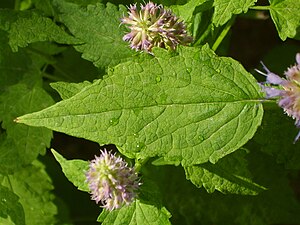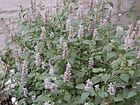Note: This is a project under development. The articles on this wiki are just being initiated and broadly incomplete. You can Help creating new pages.
Difference between revisions of "Agastache scrophulariifolia - Purple giant hyssop"
Chaithrika (talk | contribs) (+adding internal link) |
(→References) |
||
| (23 intermediate revisions by 2 users not shown) | |||
| Line 1: | Line 1: | ||
[[File:Agastache rugosa 02.JPG|thumb|right|''Korean mint '', ''Agastache rugosa'']] | [[File:Agastache rugosa 02.JPG|thumb|right|''Korean mint '', ''Agastache rugosa'']] | ||
| + | '''Agastache rugosa''' is an aromatic herb in the mint family, native to East Asia, China, Japan, Korea, Russian Primorye, Taiwan and Vietnam. | ||
| + | ==Uses== | ||
| + | {{Uses|Poor digestion}}, {{Uses|Fungal infection}}, {{Uses|Abdominal bloating}}, {{Uses|Indigestion}}, {{Uses|Nausea}}, {{Uses|Vomiting}}, {{Uses|Chest congestion}}, {{Uses|Diarrhea}}, {{Uses|Headaches}}. | ||
| − | + | ==Parts Used== | |
| + | {{Parts Used|Leaves}}, {{Parts Used|Seeds}}. | ||
| − | == | + | ==Chemical Composition== |
| + | Seasonal variations in the chemical composition of leaves fromAgastache rugosa were analyzed by gas chromatography-mass spectrometry (GC-MS). Phytotoxic and antimicrobial activities of its essential oil were investigated by characterizing 31 components, primarily methylchavicol (80.24%),dl-limonene (3.50%), linalool (4.23%), 5-methyl-2-(1-methylethylidene)-cyclohexanone (3.84%), and β-caryophyllene (2.39%)<ref name="chemical composition"/> | ||
| − | + | ==Common names== | |
| + | {{Common names|kn=|ml=|sa=|ta=|te=|hi=|en=Giant hyssop, Prairie hyssop}} | ||
| − | + | ==Properties== | |
| + | Reference: Dravya - Substance, Rasa - Taste, Guna - Qualities, Veerya - Potency, Vipaka - Post-digesion effect, Karma - Pharmacological activity, Prabhava - Therepeutics. | ||
| + | ===Dravya=== | ||
| − | == | + | ===Rasa=== |
| + | Tikta (Bitter), Kashaya (Astringent), Madhura (Sweet) | ||
| + | ===Guna=== | ||
| + | Laghu (Light) | ||
| + | ===Veerya=== | ||
| + | Sheeta (Cold) | ||
| + | ===Vipaka=== | ||
| + | Katu (Pungent) | ||
| + | ===Karma=== | ||
| + | Kapha, Vata | ||
| + | ===Prabhava=== | ||
| − | + | ==Habit== | |
| − | + | {{Habit|Perennial plant}} | |
| − | + | ==Identification== | |
| + | ===Leaf=== | ||
| + | {{Leaf|Simple|Sheen Glossy|Foliage Texture is Medium Foliage Sheen Glossy and Foliage Color is (Spring)Green, Purple}}<ref name="Leaf"/> | ||
| − | == | + | ===Flower=== |
| + | {{Flower|Unisexual|2-4cm long|White|Single|Flower Interest is Showy and Flowers are Fragrant}} | ||
| − | + | ===Fruit=== | |
| + | {{Fruit|||Showy Fruit No and Edible Fruit No and Fragrant Fruit No|Fruit Color is Tan |}} | ||
| − | == | + | ===Other features=== |
| + | |||
| + | ==List of Ayurvedic medicine in which the herb is used== | ||
| + | |||
| + | ==Where to get the saplings== | ||
| + | ==Mode of Propagation== | ||
| + | {{Propagation|Seeds}}, {{Propagation|Cuttings}}. | ||
| + | |||
| + | ==How to plant/cultivate== | ||
| + | Seed - sow spring in a greenhouse and only just cover the seed. The seed usually germinates in 1 - 3 months at 13°c<ref name="How to plant/cultivate"/> | ||
| + | |||
| + | ==Commonly seen growing in areas== | ||
| + | {{Commonly seen|Grassy places in mountains}}, {{Commonly seen|Valleys}}, {{Commonly seen|Less stony meadows}}. | ||
| − | + | ==Photo Gallery== | |
| − | < | + | <gallery class="left" caption="" widths="140px" heights="140px"> |
| − | <ref name=" | + | Agastache rugosa 01.JPG|Whole herb |
| − | + | Agastache rugosa 02.JPG|Leaves | |
| + | Agastache rugosa 03.JPG|Flower | ||
| + | Agastache rugosa 2016-04-19 8001.JPG|Whole herb | ||
| + | Agastache rugosa 2016-04-19 8002.JPG|Leaves | ||
| + | </gallery> | ||
| + | |||
| + | ==References== | ||
| + | |||
| + | <references> | ||
| + | <ref name="chemical composition">[https://link.springer.com/article/10.1007%2FBF03036127 Chemical analysis]</ref> | ||
| − | = | + | <ref name="Leaf">[https://web.archive.org/web/20131226161459/http://www.wildflowers-guide.com/39-agrimony.html Leaves description]</ref> |
| − | + | <ref name="How to plant/cultivate">[https://pfaf.org/user/Plant.aspx?LatinName=Agastache+foeniculum Cultivation details]</ref> | |
| + | </references> | ||
| + | ==External Links== | ||
| + | * [https://npgsweb.ars-grin.gov/gringlobal/taxonomydetail.aspx?1675 Agastache rugosa on U.S. National Plant Germplasm System] | ||
| + | * [https://www.rhs.org.uk/Plants/33739/Agastache-rugosa/Details Agastache rugosa on royal horticulture socaity] | ||
| + | * [https://www.gardenia.net/plant/agastache-rugosa Agastache rugosa on gardenia designing garden] | ||
| + | * [http://www.naturalmedicinalherbs.net/herbs/a/agastache-rugosa=korean-mint.php Agastache rugosa on natural meidicinal herbs] | ||
| + | * [https://myfolia.com/plants/2854-korean-mint-agastache-rugosa Agastache rugosa-How to grow Korean mint] | ||
[[Category:Herbs]] | [[Category:Herbs]] | ||
| + | [[Category:Lamiaceae]] | ||
| + | |||
| + | [[Category:Ayurvedic herbs that don't have seed photos]] | ||
Latest revision as of 18:18, 15 July 2020
Agastache rugosa is an aromatic herb in the mint family, native to East Asia, China, Japan, Korea, Russian Primorye, Taiwan and Vietnam.
Contents
- 1 Uses
- 2 Parts Used
- 3 Chemical Composition
- 4 Common names
- 5 Properties
- 6 Habit
- 7 Identification
- 8 List of Ayurvedic medicine in which the herb is used
- 9 Where to get the saplings
- 10 Mode of Propagation
- 11 How to plant/cultivate
- 12 Commonly seen growing in areas
- 13 Photo Gallery
- 14 References
- 15 External Links
Uses
Poor digestion, Fungal infection, Abdominal bloating, Indigestion, Nausea, Vomiting, Chest congestion, Diarrhea, Headaches.
Parts Used
Chemical Composition
Seasonal variations in the chemical composition of leaves fromAgastache rugosa were analyzed by gas chromatography-mass spectrometry (GC-MS). Phytotoxic and antimicrobial activities of its essential oil were investigated by characterizing 31 components, primarily methylchavicol (80.24%),dl-limonene (3.50%), linalool (4.23%), 5-methyl-2-(1-methylethylidene)-cyclohexanone (3.84%), and β-caryophyllene (2.39%)[1]
Common names
| Language | Common name |
|---|---|
| Kannada | |
| Hindi | |
| Malayalam | |
| Tamil | |
| Telugu | |
| Marathi | NA |
| Gujarathi | NA |
| Punjabi | NA |
| Kashmiri | NA |
| Sanskrit | |
| English | Giant hyssop, Prairie hyssop |
Properties
Reference: Dravya - Substance, Rasa - Taste, Guna - Qualities, Veerya - Potency, Vipaka - Post-digesion effect, Karma - Pharmacological activity, Prabhava - Therepeutics.
Dravya
Rasa
Tikta (Bitter), Kashaya (Astringent), Madhura (Sweet)
Guna
Laghu (Light)
Veerya
Sheeta (Cold)
Vipaka
Katu (Pungent)
Karma
Kapha, Vata
Prabhava
Habit
Identification
Leaf
| Kind | Shape | Feature |
|---|---|---|
| Simple | Sheen Glossy | Foliage Texture is Medium Foliage Sheen Glossy and Foliage Color is (Spring)Green, Purple |
Flower
| Type | Size | Color and composition | Stamen | More information |
|---|---|---|---|---|
| Unisexual | 2-4cm long | White | Single | Flower Interest is Showy and Flowers are Fragrant |
Fruit
| Type | Size | Mass | Appearance | Seeds | More information |
|---|---|---|---|---|---|
| Showy Fruit No and Edible Fruit No and Fragrant Fruit No | Fruit Color is Tan | {{{6}}} |
Other features
List of Ayurvedic medicine in which the herb is used
Where to get the saplings
Mode of Propagation
How to plant/cultivate
Seed - sow spring in a greenhouse and only just cover the seed. The seed usually germinates in 1 - 3 months at 13°c[3]
Commonly seen growing in areas
Grassy places in mountains, Valleys, Less stony meadows.
Photo Gallery
References
External Links
- Ayurvedic Herbs known to be helpful to treat Poor digestion
- Ayurvedic Herbs known to be helpful to treat Fungal infection
- Ayurvedic Herbs known to be helpful to treat Abdominal bloating
- Ayurvedic Herbs known to be helpful to treat Indigestion
- Ayurvedic Herbs known to be helpful to treat Nausea
- Ayurvedic Herbs known to be helpful to treat Vomiting
- Ayurvedic Herbs known to be helpful to treat Chest congestion
- Ayurvedic Herbs known to be helpful to treat Diarrhea
- Ayurvedic Herbs known to be helpful to treat Headaches
- Herbs with Leaves used in medicine
- Herbs with Seeds used in medicine
- Herbs with common name in English
- Habit - Perennial plant
- Index of Plants which can be propagated by Seeds
- Index of Plants which can be propagated by Cuttings
- Herbs that are commonly seen in the region of Grassy places in mountains
- Herbs that are commonly seen in the region of Valleys
- Herbs that are commonly seen in the region of Less stony meadows
- Herbs
- Lamiaceae
- Ayurvedic herbs that don't have seed photos





